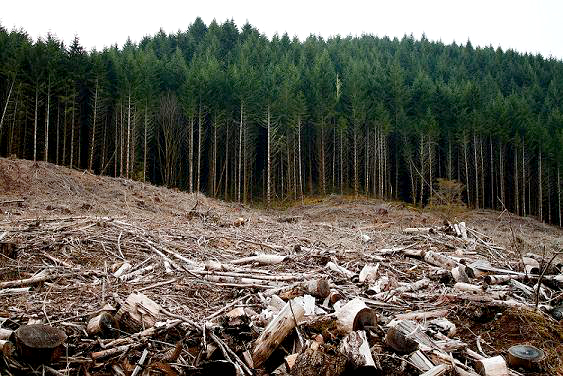07/25/2013 11:16 AM
A federal appeals judge has ruled that power plants that turn biomass into energy also have to obey the Clean Air Act.
It closed a loophole under which the Environment Protection Agency (EPA) exempted biomass plants from the same emission rules that all other power plants are subject to.
“Burning trees to generate electricity is dangerous, polluting, and
ought to be limited to protect people and the environment,” says Kevin
Bundy, a senior attorney with the Center for Biological Diversity’s
Climate Law Institute, which challenged EPA's policy. “This important
decision will reduce respiratory ailments, protect forests and help
ensure a healthier, more livable climate.”
The ruling reflects recent research that finds biomass-fueled power
plants emit significantly more carbon per kilowatt than fossil fuel
power plants - even coal. It can take decades before that excess
carbon is “re-sequestered” by subsequent plant growth, explains the
Center for Biological Diversity.
“Today’s ruling upholds EPA’s authority to regulate pollution that
drives climate change. The court’s decision is grounded in an
understanding that the science shows that biomass fuels, including
tree-burning, can make climate disruption worse,” says Ann Weeks, legal
director of the Clean Air Task Force, who argued the case
for petitioners, which include the Conservation Law Foundation
and Natural Resource Council of Maine. “The court clearly noted that the
atmosphere can’t tell the difference between fossil fuel carbon dioxide
and carbon dioxide emitted by burning trees.”
"The court's decision is particularly important for the Southeast. Now
we have an opportunity for a more sensible, science-based policy, one
that avoids clearcutting the region's wildlife-rich forests for energy
while intensifying climate change impacts," says Frank Rambo of the
Southern Environmental Law Center, which represented the Dogwood
Alliance, Georgia ForestWatch, South Carolina Coastal Conservation
League and Wild Virginia in the case.
In the case of wood, the adverse impact is exacerbated because of the
large amounts of carbon released from deep forest soils as a result of
disturbances such as logging, finds research released in June by Dartmouth College. Most global atmospheric studies don't consider deep soil, which could store up to half of all carbon in forest soils.

"Our paper suggests the carbon in mineral soil may change more rapidly,
and result in increases in atmospheric CO2, as a result of disturbances
such as logging," says Dartmouth Professor Andrew Friedland. "Increased
reliance on wood may have the unintended effect of increasing the
transfer of carbon from mineral soil to the atmosphere."
Woody biomass including trees grown on plantations, managed natural
forests and logging waste, is used for 75% of global biofuel production.
“If we are going to start changing recommendations and tell people to
leave oil and coal in the ground, and burn more wood, we first need
solid science behind that recommendation,” says Friedland. “Wood still
might be a green choice, but let’s know all the consequences of
everything that we do—and some of these consequences are not currently
being discussed or appreciated or evaluated.”
Next-Generation Biofuel Investments in Doubt
Meanwhile, Europe’s biggest oil companies, BP and Shell, are scaling back investments in biofuels because
they don't see them becoming economical to produce until at least 2020.
Exxon (remember all those algae TV ads?) and Chevron gave up several
years ago, when they didn't see enough profit.
Why bother with these longer term investments when they're making a killing on their core business, oil and gas?
Why bother with these longer term investments when they're making a killing on their core business, oil and gas?
Global investment in biofuel production was $57 million in the first quarter, the lowest since 2006 and off significantly from a peak of $7.6 billion in the last quarter of 2007, reports Bloomberg.
“Progress in deploying these technologies has been slower than many had
anticipated and what’s needed to keep on track with our aspirations,”
Maria van der Hoeven, executive director of the International Energy
Agency (IEA), told Bloomberg. “Many potential producers have found it difficult to secure the capital they need.”
Last year, BP scrapped plans for a $300 million refinery in Florida, although it just opened a $520 million wheat-to-ethanol facility in the UK with DuPont. Shell canceled plans in April for a straw-to-ethanol facility and also pulled back funding for biofuel enzymes at Codexis and an algae venture with HR BioPetroleum.
"All of these technologies are capable of working technically," Matthew Tipper, Shell's head of alternative energy, told Bloomberg. "It was purely on cost that this technology couldn't be taken forward. Fuels have to be cheap enough to burn. Otherwise no-one will buy them."
Both the US and Europe are counting on biofuels to help reduce emissions
that contribute to global warming. To meet climate targets, biofuels
must account for 27% of transportation fuels by 2050, up from just 3% in
2012, says IEA.
Last year, ethanol made from sugar or corn was the major source of
biofuels - almost all of the 1.9 million barrels produced a day.
Next-generation technologies are focused on supplies that don't compete
with food, such as switch grass, corn stalks, jatropha and algae, as
well as wood waste from the lumber and paper industries.
The first commercial-scale cellulosic biofuels plants are coming online, from companies like KiOR, Abengoa Bioenergy, BlueFire Renewables, Mascoma and Fulcrum Bioenergy.
The plants will boost US cellulosic biofuel output 20-fold this year.
At an anticipated 9.6 million gallons of production, it falls short of
government’s target of 14 million gallons.
Big oil has basically decided to let these smaller firms develop the technologies and then surely they'll step in.
Last year, the EU set limits on crop-based biofuels because of rising food prices worldwide and shifted the focus to agricultural residues like straw, and potentially algae.
Big oil has basically decided to let these smaller firms develop the technologies and then surely they'll step in.
Last year, the EU set limits on crop-based biofuels because of rising food prices worldwide and shifted the focus to agricultural residues like straw, and potentially algae.
